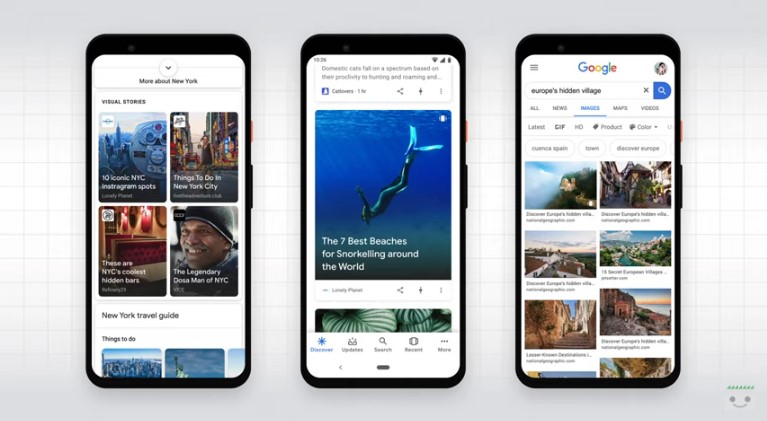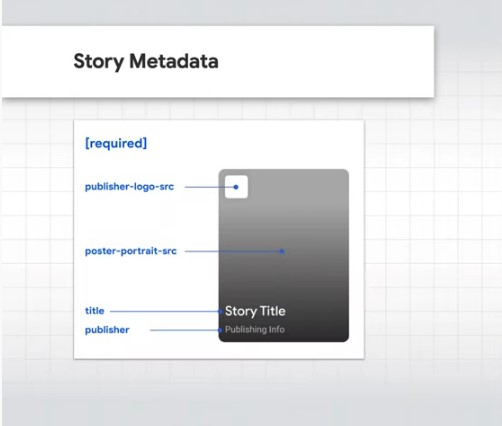SEO for Web Stories: the optimizations for organic search results
The spotlight is once again on Google Web Stories, the snack content that for some time now appear in various products of the Big G ecosystem and that are receiving great interest from readers for their characteristics. At the heart of the new video series Search Central Lighting Talks on Youtube, in fact, there are the SEO tips for Web Stories and to monitor their performance in Search.
From Google SEO tips for Web Stories
The episode is entrusted to Pascal Birchler, Google’s Developer Relations Engineer, who guides the discussion by taking an overview of the topic, starting to explain what web stories are, how to create them and how to place ads inside them, so that online marketer, bloggers or site owners can take full advantage of it.
The story format has become popular for some years on major social media and since 2019 have also landed on Google: at the time they were still called AMP Stories, but they were already a “modern and engaging tool for an immersive storytelling on a website, which allows you to maintain full control over the experience and monetization“.
What are Web Stories and why they are useful to editors
In essence, Web Stories are a web-based version of the popular story format developed by various social apps, which brings together videos, images, animations and text “to create fully immersive fullscreen experiences, typically consumed in portrait mode on the smartphone”.
The stories allow the user to explore the content at their own pace, tap through them or swipe from one piece to the next.
Unlike their social counterparts, Web Stories allow the publisher to create beautiful and engaging content” with full control over the experience and monetization”.
Every decision, “from how to monetize your story to how long it stays online, depends on you,” says Birchler: this freedom offers “great creative flexibility and the ability to easily link to your other content, making Stories a natural part of your website”.
How to create Web Stories
The Googler explains that web stories are part of the open web and “under the hood are essentially normal HTML pages“; this means that they can be hosted on your own server and easily shared or embedded in sites and applications, without any restrictions on the ecosystem.
There are some ways to create Web Stories, depending on your needs and skills.
- Being only web pages, you can build web stories “by hand”: this is particularly useful “when you want to create stories with highly customized features”, but – as with normal web pages, It is important to have the right tools at hand to create this content, because “not everyone is a developer”.
- For this reason, there are independent story editing tools that help accelerate the content creation process without having to write a single line of code. Tools such as Makestories, Visual Stories or Newsroom AI (to name a few of those that already exist today) allow you to achieve better results thanks to visual editing and guidance along the way.
- Third mode, valid if your site is built using a CMS, you use a dedicated tool, such as the Web Stories plugin for WordPress, that allows to integrate the stories seamlessly into the existing editorial workflow and to make them an integral part of the site. These editors make it “easy and fun to produce visually amazing stories and guide you towards a beautiful end result, taking care of all the heavy work, so that you can focus on the actual creation of the story itself”. In particular, the Google tool uses “an intuitive WYSIWYG interface and useful building blocks to start quickly”.
How to optimize and maximize Web Stories results
But even the best story “is worth nothing if it doesn’t make you more successful”, Birchler clarifies, and it is therefore important to understand how to “get the most out of Web Stories using the various techniques and platforms available”.
After all, the ultimate goal of this product – editor side – is to make sure “that stories benefit your overall strategy and produce a ROI, return on investment”and so – after the creative advice provided some time ago – it is time to focus on the technical aspects.
Web Stories in Google products
There are 3 Google surfaces on which Web Stories can appear: the traditional Search, Discover but also the Image Search.
In Search, the appearance may vary “from a single search result to a visual carousel that shows multiple stories, depending on the country and language”. For example, “when people look for things to do in New York, the grid view shows Web Stories by multiple publishers”.
SEO for Web Stories
The first step to allowing stories to be found and indexed by search engines is to think about SEO.
In a nutshell, you have to apply for Web Stories all the SEO best practices that you put into practice for every other page of the website: if these are already used to classify non-stories pages, then “probably will also help Web stories”, says Birchler.
In practical terms, among the best practices it is recommended to add meta description and to include stories in XML sitemaps. In addition, there are also some specific requirements for stories to keep in mind, such as providing some necessary metadata, such as a poster image and a publisher logo.
To measure and improve the performance of Stories you can use the Search Console and “better understand how Google sees your pages“: its various tools and reports help to analyze traffic, solve potential problems “and make your stories shine in Google search results”.
Guidelines for Web Stories
To be suitable for display in the various Google products, Web Stories must comply with certain guidelines.
The most important thing is that they must be valid AMPs: a valid AMP stories “is the one that adheres to the various AMP specifications”, which allow the story to be served through the AMP cache, ensuring good performance and the best experience for users.
To check if the web story is AMP valid you can use the Web Stories test tool, typing or pasting its URL. This tool also lets you preview how the story will look in Google search results, so you can decide if it needs any further changes.
After publishing the story and validated using the test tool “it’s time to share it with the world” and figure out how to measure how the audience interacts with the story, looking for answers to questions like “How much time do they spend on a page? Click on the call-to-action links?” thanks to a wide range of providers, including Google Analytics.
Monetization with Web Stories
Monetization is an important aspect for publishers on the web, and for Web Stories it is as relevant as with other types of content.
In Web Stories there are various monetization options: for example, full screen immersive ads allow a perfect integration into the user’s journey.
The easiest way to include them “is through an ad server, like Google Ad Manager, or via Adsense“: because the Runtime of Web Stories manages the amount and placement of ads, just “set everything only once and you can then forget about it”.
Integration between Web Stories and Website
An aspect not to be neglected is the integration of Web Stories within the classic Web site: as pointed out in the video, the stories can “shine there” and, for example, you can incorporate the stories in an autonomous space (a standalone player, highlighted by the home) or show a carousel of favorite stories.
By linking content in this way, readers can easily reach stories from other parts of the website and vice versa.
While “various components and examples exist for this and can be implemented manually, the story editor you have chosen probably already offers such out of the box integrations”.
The benefits of the Web Stories editor for WordPress
“SEO, Analytics, AMP, monetization… are quite a few things to deal with”, says in the conclusions the Googler, which however invites you to use the tools to create stories like Web Stories for WordPress, which are of huge help to “set things up and keep control over everything“.
Such tools “not only provide solid configurations defined out of the box for aspects such as analytics and ad service, but also include the metadata needed for stories and say when something needs optimization”.
Through integrations with other aspects of the website, you can measure the success of web stories “all in one place” and thus exploit the full potential of this important type of content.




